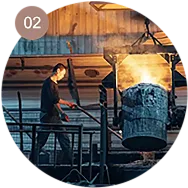
commercial dutch oven
The Versatility of the Commercial Dutch Oven
When it comes to kitchen essentials, few items can claim the versatility and enduring popularity of the Dutch oven. Particularly in commercial settings such as restaurants and catering companies, the commercial Dutch oven stands out as an indispensable tool for chefs. Its robust construction and multifunctional design enable professionals to create a wide array of dishes, making it a favorite in kitchens around the world.
History and Evolution
The history of the Dutch oven dates back centuries, with roots that can be traced to 18th-century Europe. Originally made of cast iron, these ovens were designed to withstand high heat and deliver even cooking results. The design has evolved over time, incorporating innovations such as enamel coatings and non-stick surfaces, but the core functionality remains the same. In commercial kitchens, where efficiency and consistency are paramount, the modern commercial Dutch oven marries traditional craftsmanship with cutting-edge technology.
Design and Features
Commercial Dutch ovens are typically made from cast iron, providing exceptional heat retention and distribution. This material ensures that food cooks evenly, eliminating hot spots that can lead to uneven cooking. Many commercial models also come with a porcelain enamel finish, which enhances durability and makes cleaning easier. This feature is especially important in busy kitchens where time is of the essence.
In addition to their strength and heat retention, commercial Dutch ovens often feature heavy lids designed to lock in moisture, which is crucial for braising and stewing. The weight of the lid helps create a self-basting effect, keeping dishes tender and flavorful. Furthermore, many commercial Dutch ovens are designed to be used on various cooking surfaces, including induction, gas, and electric stovetops, as well as in ovens, making them extremely versatile.
commercial dutch oven

Culinary Applications
Chefs appreciate the commercial Dutch oven for its wide range of applications. From slow-cooked stews and braises to baking artisan bread, the possibilities are virtually endless. The ability to go seamlessly from stovetop to oven is a significant advantage, allowing chefs to start browning meat, for example, and then transfer the pot into a preheated oven without the need for additional cookware. This not only saves time but also reduces the amount of equipment that requires washing after service.
In addition to traditional dishes, the commercial Dutch oven is perfect for preparing soups, casseroles, and even desserts like cobblers. Its ability to retain heat means that meals can stay warm for extended periods, making it ideal for buffets and family-style dining setups common in many commercial establishments.
Maintenance and Care
Taking care of a commercial Dutch oven is essential to prolong its life and maintain its performance. While most models are dishwasher safe, hand washing is often recommended to preserve the enamel and prevent chipping. A gentle scrub with mild soap and a soft sponge is usually more than enough to keep it in pristine condition. Regular seasoning, if using bare cast iron, can help maintain its non-stick properties and prevent rusting.
Conclusion
In conclusion, the commercial Dutch oven is a powerhouse of culinary potential. Its robust construction, versatility, and ability to create delicious, hearty meals make it a mainstay in commercial kitchens worldwide. Chefs who appreciate quality and efficiency will find that this tool not only meets but exceeds their cooking demands. As trends in cooking evolve, the commercial Dutch oven remains a timeless appliance that proves indispensable for both everyday meals and gourmet creations. Whether you’re simmering a rich, savory stew or baking a crusty loaf of bread, the commercial Dutch oven is a reliable partner in culinary excellence.
-
Season Cast Iron Perfectly with GPT-4 Turbo TipsNewsAug.01,2025
-
High Quality Cast Iron Cookware - Baixiang County Zhongda MachineryNewsAug.01,2025
-
Premium Cast Iron Pan: Durable & Perfect HeatNewsAug.01,2025
-
High Quality Kitchen Durable Black Round Cast Iron Cookware Pancake Crepe Pan-Baixiang County Zhongda Machinery Manufacturing Co., Ltd.NewsAug.01,2025
-
Cast Iron Cookware - Baixiang County Zhongda Machinery | Nonstick, Heat ResistanceNewsAug.01,2025
-
High Quality Kitchen Durable Black Round Cast Iron Cookware - Baixiang County Zhongda Machinery | Non-Stick, Heat Retention, DurableNewsJul.31,2025


